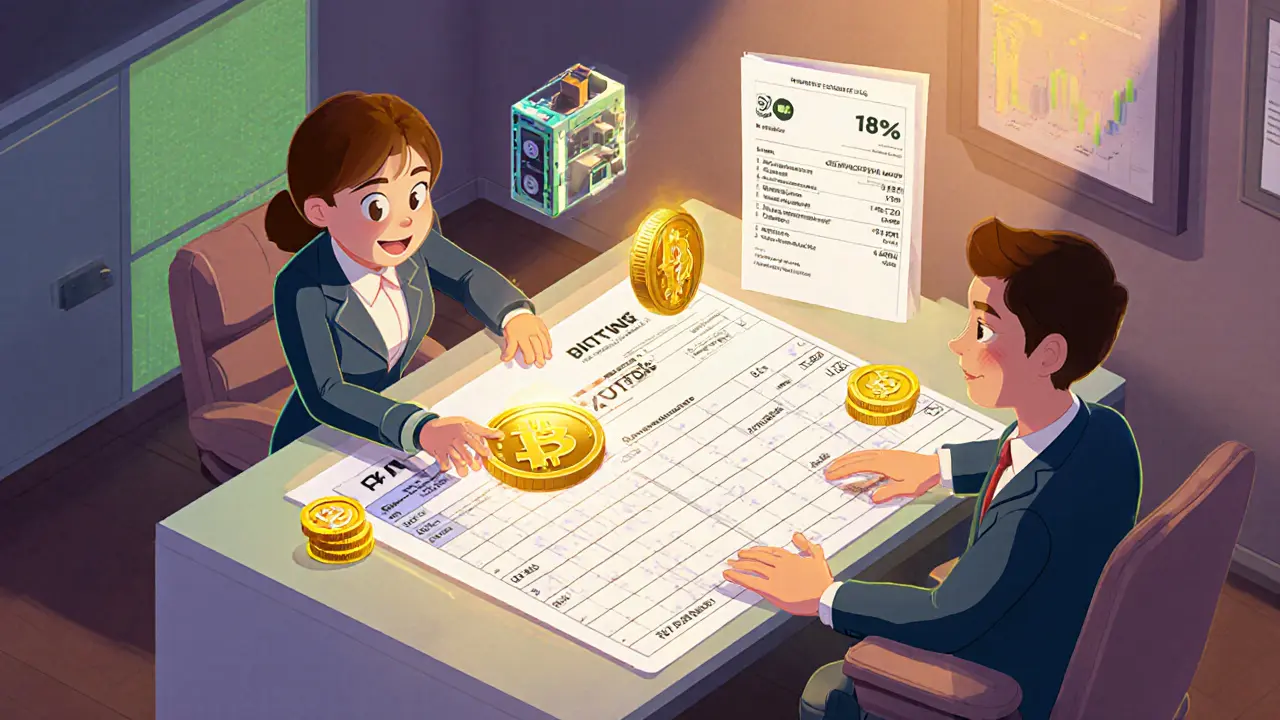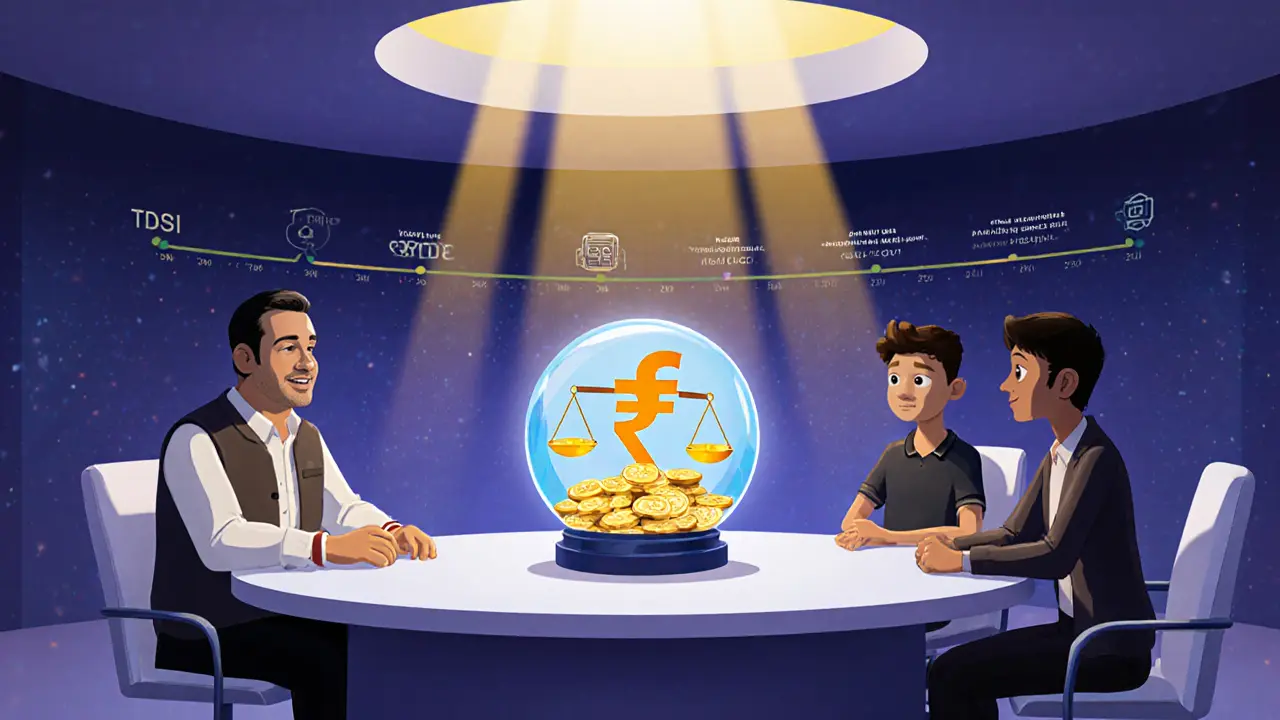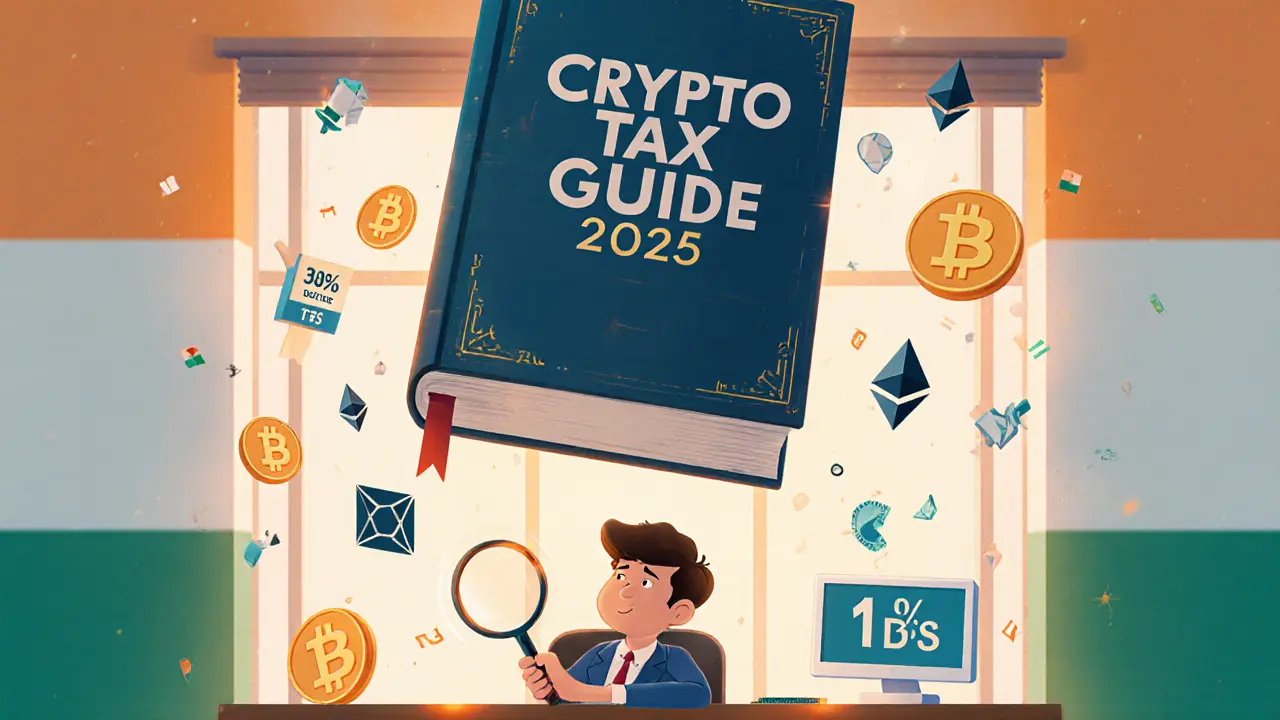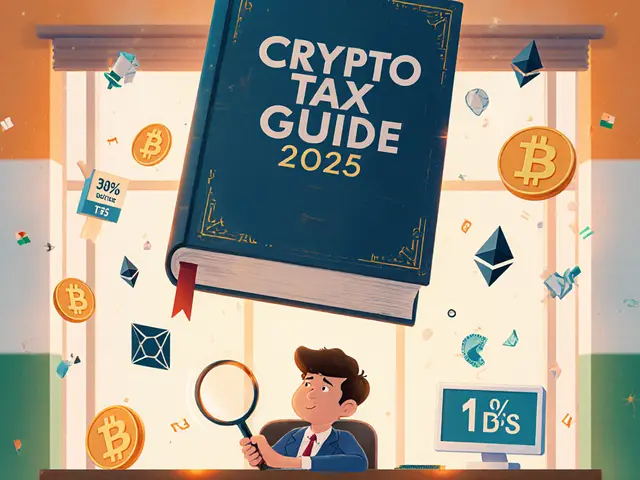Key Takeaways
- India taxes crypto gains at a flat 30% plus 4% cess, with no indexation.
- A 1% TDS (Section 194S) applies to every transaction over ₹10,000.
- From July 2025, crypto‑exchange fees attract 18% GST.
- Mining, staking and airdrops are treated as ordinary income at slab rates.
- Compliance tools can cut filing time from 12hours to under 3hours per quarter.
Understanding Crypto taxation in India feels like decoding a new language. The Finance Act 2022 introduced the term "Virtual Digital Assets" (VDAs) and slapped a 30% flat tax on any profit you make. On top of that, a 1% Tax Deducted at Source (TDS) starts choking every trade over a modest threshold, and from mid‑2025 you’ll also see an 18% GST on exchange fees. This guide walks you through what the law actually says, shows you how to calculate your liability, and gives you a checklist to stay on the right side of the Income Tax Department.
What the Law Calls Crypto: Virtual Digital Assets (VDAs)
Virtual Digital Assets are defined in Section 2(47A) of the Income Tax Act, 1961 as any digital representation of value that can be transferred, stored or traded electronically. The definition explicitly covers Bitcoin, Ethereum, NFTs and all tokens that function like a currency, but it excludes gift cards or vouchers.
The Core Tax Structure
The Indian framework works on two parallel tracks:
- Capital gains tax: A flat 30% on the profit from each VDA sale, plus a 4% health & education cess (effective 31.2%). No indexation, no holding‑period discounts.
- Tax Deducted at Source (TDS): Section 194S mandates a 1% TDS on every crypto transaction exceeding ₹10,000 for regular taxpayers (₹50,000 for specified persons). The exchange must deduct and remit the amount, then issue a TDS certificate.
Both taxes are independent - you pay the 30% on the profit and also settle any TDS liability. If your TDS exceeds your tax due, you can claim a credit while filing your return.
How to Compute Your Tax Liability
Step‑by‑step, here’s what you need to do each financial year:
- Gather the complete transaction ledger from every exchange you used - timestamps, wallet addresses, and INR value at the exact moment of each trade.
- Identify the acquisition cost for each unit sold. If you bought in batches, use the FIFO (first‑in‑first‑out) method, which the Income Tax Department accepts as a standard practice.
- Calculate the profit: Sale Consideration - Acquisition Cost = Gain. That figure is taxed at 30% plus cess.
- Sum all TDS amounts deducted by exchanges. These appear on your Form16A (or the exchange‑issued TDS certificate).
- File ITR‑3 or ITR‑4 (as applicable) and claim the TDS credit in the "Tax Paid and Deposited" section.
For assets received without purchase price - such as mining rewards, staking tokens or airdrops - the fair market value on the day of receipt is treated as ordinary income and taxed at your personal slab rates.

GST on Crypto Platform Services (Effective July 2025)
Goods and Services Tax (GST) now applies to every fee charged by crypto exchanges to Indian users. The CBIC (Central Board of Indirect Taxes and Customs) classifies these platforms as “Online Service Providers” under Section 2(102) of the CGST Act. The applicable rate is 18% on:
- Spot‑trading fees
- Margin‑trading and derivatives commissions
- Staking‑reward processing fees
- Deposit/withdrawal charges
Exchanges must register for GST irrespective of turnover, issue GST‑compliant invoices and cannot rely on the reverse‑charge mechanism. This adds roughly 15‑20% to operational costs, which many platforms are passing on to traders as higher fees.
Common Scenarios & Practical Examples
Example 1 - Simple Buy‑Sell Trade
Buy 0.5BTC on 1Jan2024 for ₹1,200,000. Sell on 1July2024 for ₹1,600,000.
- Gain = ₹400,000.
- Capital gains tax = 30%×₹400,000 = ₹120,000.
- Cess (4%) = ₹4,800.
- Total tax = ₹124,800.
- TDS: 1% of ₹1,600,000 = ₹16,000 (already deducted by exchange).
- Net tax payable after TDS credit = ₹124,800 - ₹16,000 = ₹108,800.
Example 2 - Mining Reward
Mine 2ETH on 15Mar2025, fair market value at that date = ₹120,000 each.
- Income recognized = ₹240,000.
- Taxed at individual slab - say 20% = ₹48,000 + 4% cess = ₹1,920.
- No TDS on mining rewards, so full amount payable.
Tools & Tips to Reduce the Compliance Burden
Doing the math manually is a nightmare, especially with volatile prices. Here are the most popular Indian‑focused solutions:
- KoinX: Imports CSV files from major exchanges, auto‑applies FIFO, generates TDS credit reconciliation report.
- CoinTracker India: Cloud‑based, handles staking and DeFi token flows, offers audit‑ready PDFs.
- CryptoTaxCalculator: Free tier for up to 100 trades, includes GST calculations for platform fees.
Using any of these can cut your quarterly filing time from 8-12hours to under 3hours.

Checklist Before Filing Your Return
| Task | Why It Matters | How to Verify |
|---|---|---|
| Export full transaction history from every exchange | Ensures no trade is missed | Check CSV count matches dashboard total |
| Calculate cost basis using FIFO | Mandatory method recognized by CBDT | Cross‑verify with KoinX report |
| Collect all TDS certificates (Form16A) | Needed for credit claim | Match TDS amount with exchange statements |
| Identify non‑sale incomes (mining, staking, airdrops) | Taxed at slab rates | Use fair market value on receipt date |
| Compute GST on platform fees | Additional 18% liability | Gather invoice PDFs from exchanges |
| File ITR‑3/ITR‑4 with Schedule C | Correct return category for VDAs | Confirm Schedule C shows VDA income |
| Claim TDS credit in “Tax Paid and Deposited” section | Avoid double taxation | Ensure credit equals total TDS deducted |
Comparing India’s Crypto Tax with Other Jurisdictions
| Country | Tax Rate on Gains | TDS/Withholding | GST/VAT on Platform Fees |
|---|---|---|---|
| India | 30% flat + 4% cess | 1% TDS (Section 194S) | 18% GST |
| United States | 0‑20% long‑term, 10‑37% short‑term | None | Varies by state (generally sales tax) |
| Portugal | 0% for non‑professional traders | None | 23% VAT on services |
| Singapore | Taxed as ordinary income (progressive) | None | 7% GST on platform fees |
India’s 30% flat rate is among the highest, and the simultaneous TDS makes it unique. No jurisdiction combines a withholding tax with a flat capital‑gains levy.
Future Outlook: What Might Change?
The Joint Committee on Virtual Digital Assets is slated to submit recommendations by March 2026. Early drafts suggest two possible tweaks:
- Raising the TDS threshold to ₹100,000 to ease the burden on small traders.
- Introducing a distinction between short‑term (<1year) and long‑term holdings, potentially lowering the rate for the latter.
Meanwhile, the Reserve Bank of India’s e‑Rupee project is progressing, positioning a sovereign digital currency alongside the taxed crypto market. If the e‑Rupee gains traction, we could see a shift in user preferences toward the regulated digital rupee, but the VDA tax framework is expected to stay the main tool for managing decentralized assets for the foreseeable future.
Frequently Asked Questions
Is crypto considered a capital asset in India?
Yes. Under the Finance Act 2022, cryptocurrencies are classified as Virtual Digital Assets, subject to capital‑gains tax.
Do I have to pay tax on crypto I received as an airdrop?
Airdrops are treated as ordinary income. The fair market value on the receipt date is added to your taxable income and taxed at your slab rate plus cess.
Can I claim the 1% TDS as a credit?
Yes. When filing your ITR, report the TDS amount in the “Tax Paid and Deposited” section. The credit will reduce your overall tax liability.
How does GST affect my trading costs?
Exchanges must charge 18% GST on every service fee they levy - trading commissions, staking fees, withdrawal charges, etc. This GST is payable by you as part of the fee you see on the platform.
What records do I need to keep for audit purposes?
Maintain the full transaction CSVs, wallet address statements, exchange‑issued TDS certificates (Form16A), and any GST invoices. The Income Tax Department’s AIS now includes VDA data, so any mismatch can trigger a notice.


Comments
Sure, because paying 30% on crypto gains is just a vacation.
Let’s break this down, folks. The 30% flat tax isn’t a myth, it’s the law, and the 4% cess makes it even steeper. If you’re trading daily, that 1% TDS will eat into your profits faster than you can say ‘buy low, sell high.’ Tools like KoinX or CoinTracker can shave hours off your filing nightmare. Remember, every exchange must issue a Form 16A – keep those handy for your return.
Honestly, the GST on exchange fees is a killer. It’s basically another hidden tax on top of the 30%.
First, the Income Tax Act defines Virtual Digital Assets quite broadly, encompassing everything from Bitcoin to NFTs, but deliberately leaving out gift‑cards and vouchers. Second, the flat 30% tax applies to each profit transaction, without any benefit from indexation – a fact many newbies overlook. Third, the 4% health and education cess is calculated on the tax, effectively raising the rate to 31.2%. Fourth, Section 194S imposes a 1% TDS on any trade above ₹10,000, which the exchange must deduct and remit before you even see the proceeds. Fifth, if the TDS you paid exceeds your final tax liability, you can claim a credit during filing – a crucial mitigation step. Sixth, mining rewards, staking income, and airdrops are treated as ordinary income and taxed at your personal slab rates, not the flat 30%. Seventh, the GST of 18% on exchange fees, effective July 2025, adds another layer of cost that cannot be offset. Eighth, every exchange must register for GST regardless of turnover, meaning you’ll see higher invoices. Ninth, the compliance tools listed – KoinX, CoinTracker India, CryptoTaxCalculator – automate FIFO cost basis calculations and TDS credit reconciliation. Tenth, using these tools can reduce your quarterly filing time from 8‑12 hours to under 3 hours, a huge productivity win. Eleventh, you must export the full transaction ledger from each platform to avoid missing any trade. Twelfth, the FIFO method is accepted by the tax authorities, so you should stick with it unless you have a strong reason to do otherwise. Thirteenth, always retain the TDS certificates (Form 16A) for each exchange as proof of tax withheld. Fourteenth, the checklist before filing includes verifying GST invoices, TDS certificates, and accurate cost basis reports. Fifteenth, staying ahead of the proposed amendments – like raising the TDS threshold – can save you from future headaches. In summary, meticulous record‑keeping and leveraging automation are your best defenses against a complex tax regime.
In my opinion, the most critical aspect is the timing of filing. The Revenue Department has been quite punctual in issuing notices for non‑compliance, and penalties can compound quickly. It is advisable to align your fiscal calendar with the exchange reporting cycles, thereby ensuring all TDS takings are captured in the same quarter. A minor misspelling in the form can sometimes delay processing, so double‑check headings. Ultimately, a disciplined approach saves both money and sanity.
From an expert perspective, the key is reconciling the TDS amounts shown on the exchange statements with the Form 16A you receive. Any discrepancy can trigger a notice, and the CRA will ask for explanations. Use the CSV export feature and run a simple pivot table – it’ll highlight mismatches instantly. Also, remember to claim the TDS credit in the “Tax Paid and Deposited” section of ITR‑3/ITR‑4.
Yo, just remember the 1% TDS is on the gross transaction amount, not the profit. That’s a trap for the unwary.
It is morally indefensible that the government imposes such a draconian levy on digital innovators. One must question whether the policy truly serves the public interest or merely penalises forward‑thinking citizens. Moreover, the lack of indexation eradicates any incentive for long‑term holding, which could stifle market stability. Such measures could be deemed counter‑productive to economic growth.
Totally agree with the above; the GST on platform fees feels like a hidden surcharge. If you’re using multiple exchanges, those 18% can add up fast. Make sure you pull the GST invoices and include them in your final return, otherwise you’ll miss a deductible expense.
Look, the crypto tax code is basically a labyrinthine beast – you need a torch, a map, and maybe a coffee IV drip to navigate it. The jargon alone (VDAs, FIFO, GST, TDS) could make a seasoned accountant break out in hives.
Patriotic crypto traders, beware!!! The state is watching every transaction!!! 1% TDS is just the tip of the iceberg!!! 🇮🇳💰
Great, another tax to love.
Another fee? Nice.
Hey folks, just a gentle reminder: keep your transaction logs organized. It’ll make filing way less painful.
Thank you for the reminder! I’ve been using CoinTracker India for the past few months and it’s been a lifesaver – especially when reconciling staking rewards with ordinary income.
Let’s keep the momentum! Remember, the more you automate, the less you’ll stress during tax season. 💪🚀
Just a heads‑up – double‑check your GST invoices. Many people overlook the 18% charge and end up with a surprise bill.
Indeed, overlooking GST is a common mistake. More importantly, the tax department may audit you if inconsistencies appear, so keep every receipt. Discipline now prevents penalties later.
From a practical standpoint, the 30% flat tax is unforgiving, but the real pain point is the administrative overhead. Use an aggregator to pull data from all exchanges; it’s a game‑changer.
Stay positive, everyone! 📈 With the right tools, filing can be a breeze. 🌬️✨
Good point! 😎 I always keep the Form 16A PDFs handy – they’re essential for the TDS credit claim.
Our nation’s fiscal policies must reflect strength; the 30% rate sends a clear message about the seriousness of crypto trading.
One cannot help but notice the pretentiousness of labeling digital assets as “Virtual Digital Assets.” It reeks of bureaucratic grandstanding.
Philosophically, taxation on intangible assets raises questions about the nature of value itself. When does a token become a taxable entity?